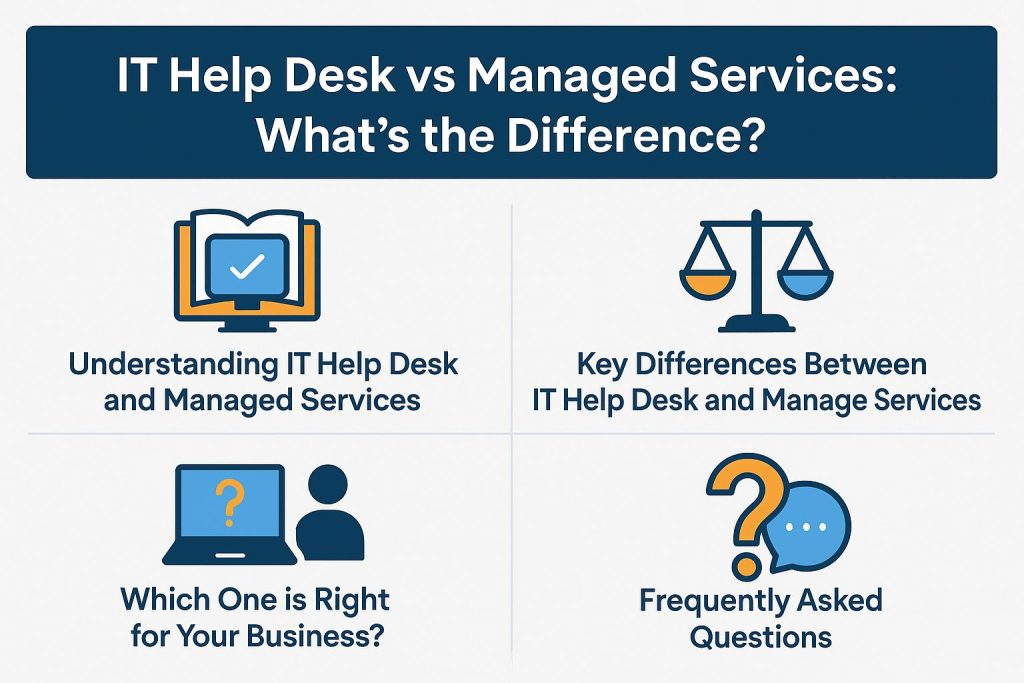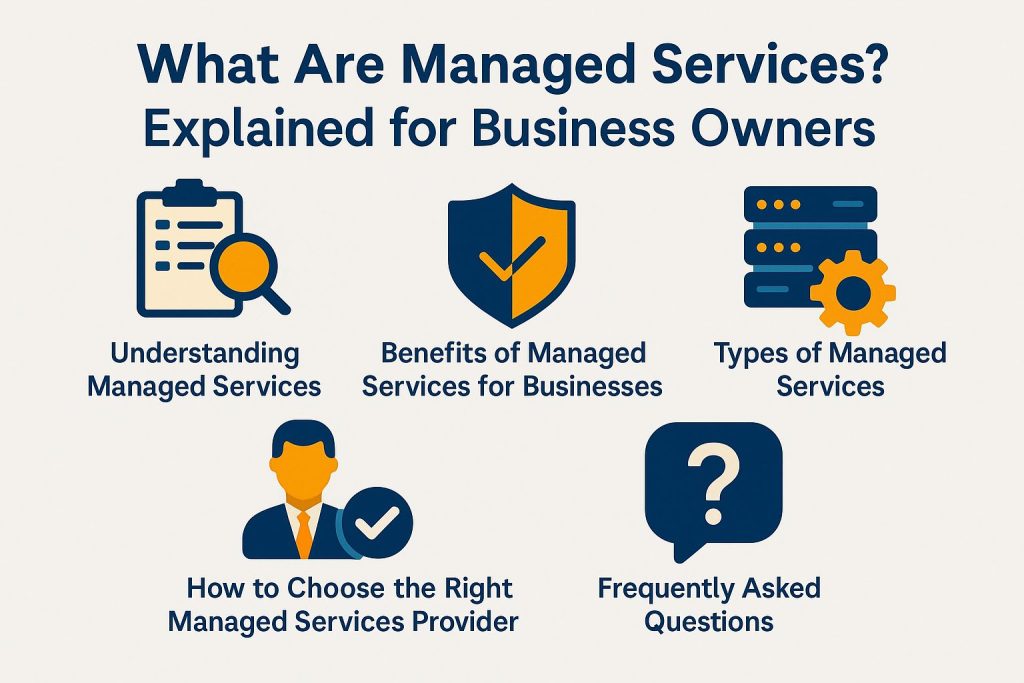How Managed IT Services Reduce Downtime and Boost Productivity

Today, businesses rely on technology to operate and serve clients. Downtime disrupts productivity and causes lost revenue. These services reduce interruptions. Managed IT services provide monitoring, disaster recovery, cloud solutions, and 24/7 support. These services minimize interruptions. This article examines the impact of downtime on productivity, how managed IT services help mitigate these risks, and the benefits of adopting this essential business strategy.
Organizations can learn how optimizing their IT infrastructure can lead to enhanced efficiency, cost savings, and access to advanced technology management solutions.
What are Managed IT Services?
Managed IT Services include IT support and expertise. They improve business operations. These services ensure the optimal performance of IT infrastructure while integrating necessary cybersecurity measures and IT governance practices. Tailored to meet specific business needs, they provide proactive maintenance, service level agreements, and support to minimize downtime and improve productivity.
By leveraging cloud computing and remote management solutions, organizations can enhance their IT strategy, improve IT alignment with business goals, and ultimately drive innovation and efficiency.
Typically, Managed IT Services include:
- Data backup and recovery solutions, which are essential for safeguarding business-critical information against potential loss due to cyber threats or hardware failures.
- The incorporation of advanced cybersecurity measures that not only protects sensitive data but also fosters trust among clients and stakeholders.
In a changing tech landscape, businesses benefit from expert guidance on cost-effective, scalable solutions. This flexibility, combined with access to a skilled team of IT professionals, enables organizations to focus on their core operations while ensuring that their technological needs are met effectively. For an extensive analysis of how these services integrate seamlessly into business operations, our comprehensive study on integrating IT services provides valuable insights.
Impact of Downtime on Productivity
Downtime impedes productivity. This leads to lost revenue and lower employee engagement.
In today’s fast-paced business world, downtime can result in significant financial losses. Organizations encounter significant challenges when IT systems experience failures, as this disrupts business continuity and negatively impacts overall operational efficiency.
In today’s fast-paced environment, where performance metrics and employee productivity hold critical importance, the effects of even brief interruptions can have enduring consequences on an organization’s financial performance.
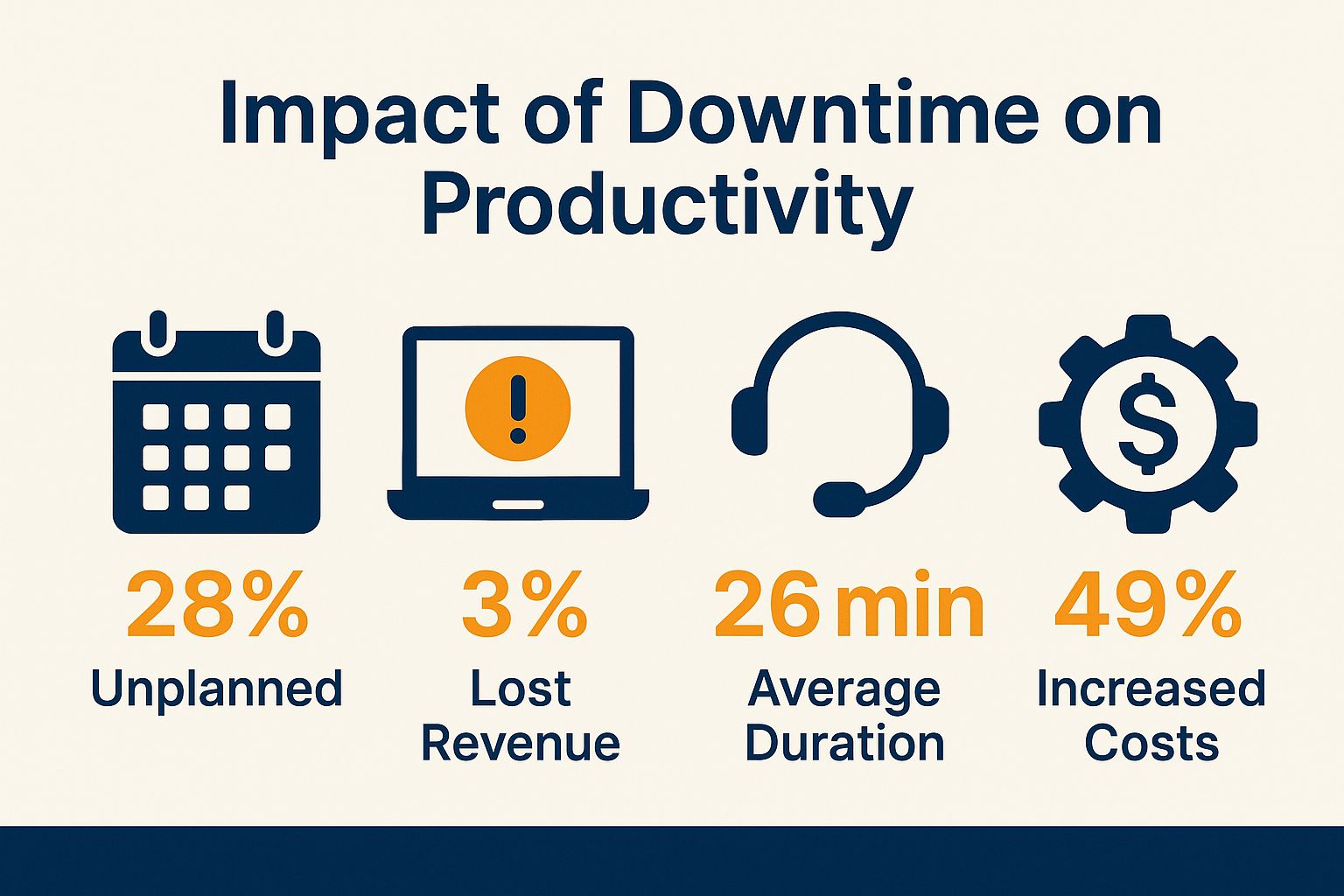
Statistics on Downtime and its Effects
Statistics show downtime causes financial losses, often thousands of dollars per hour. This underscores the critical need for effective risk management, incident management strategies, and business continuity planning.
Research shows that the average cost of downtime across various sectors can reach as high as $5,600 per minute, translating to over $330,000 per hour for certain organizations. Additionally, a study conducted by the National Cyber Security Alliance reveals that 60% of small businesses that experience a cyber attack cease operations within six months, illustrating the severe repercussions of unaddressed vulnerabilities.
Organizations that frequently encounter outages not only suffer financial setbacks but also face reputational damage and diminished customer trust. This shows the need for businesses to implement strong strategies to reduce risks and ensure resilience.
Ways Managed IT Services Reduce Downtime
Managed IT Services are essential in minimizing downtime through a range of strategic initiatives, including proactive maintenance, network management, and comprehensive disaster recovery planning.
By utilizing advanced cloud solutions and dedicated IT support teams, organizations can efficiently address technical issues, optimize system performance, and ensure the reliable operation of their IT infrastructure. This is further supported by consistent and robust IT support services, which you can explore through our 24/7 Tech Support (providing round-the-clock assistance).
Furthermore, continuous system monitoring improves visibility into potential threats, enabling prompt incident response and effective long-term risk mitigation.
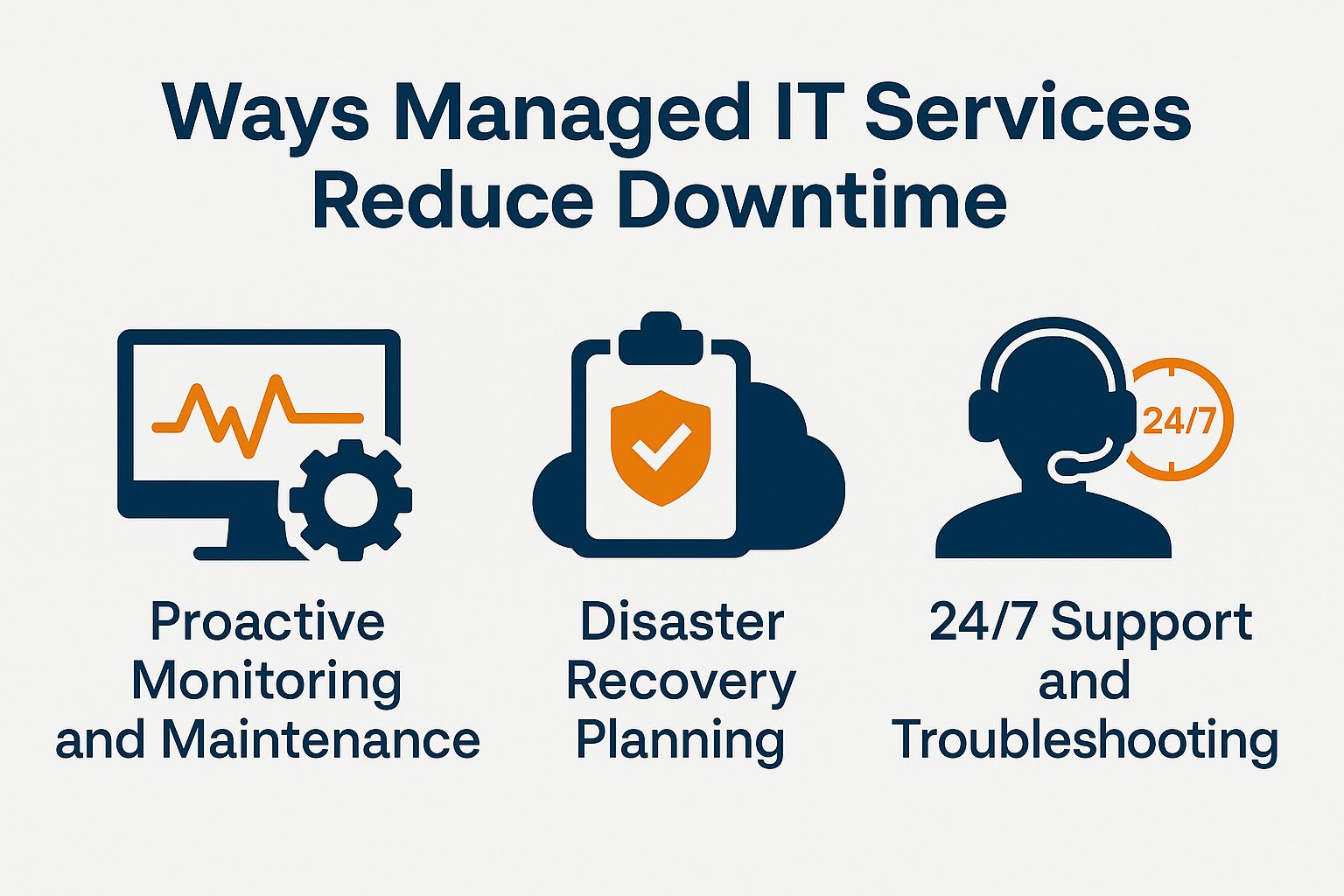
Proactive Monitoring and Maintenance
Proactive monitoring and maintenance are key parts of Managed IT Services. They ensure system performance and prevent small issues from becoming big problems.
Advanced monitoring tools help IT support teams find problems quickly. This allows for fast incident management and lowers the risk of system failures.
This proactive approach not only improves operational efficiency but also enhances user experience across the organization. This approach leads to better business continuity and a more effective allocation of resources.
To achieve these objectives, various methodologies such as predictive analytics, performance analytics, and automated monitoring systems are employed, helping to forecast potential outages or performance bottlenecks. Tools like Application Performance Management (APM) software and Network Monitoring solutions are important. They provide insights into network traffic and application behavior.
By continuously tracking these metrics, organizations can implement timely corrective measures, ensuring higher reliability of systems. Ultimately, this results in minimized downtime and a smoother operational landscape, where IT services seamlessly support business goals and objectives.
Planning for Disaster Recovery
Disaster recovery planning is a critical component of Managed IT Services, specifically designed to ensure business continuity in the event of unexpected disruptions. Organizations can protect their critical information by implementing data backup solutions and creating system redundancy. This helps minimize downtime.
Effective disaster recovery strategies reduce risks and help organizations comply with IT governance frameworks.
This process encompasses several key components, beginning with regular data backups that safeguard against data loss caused by hardware failures or cyberattacks. Organizations should adopt both on-site and off-site backup solutions to create multiple layers of security.
Additionally, system redundancy strategies, such as utilizing duplicate servers and network systems, are essential for maintaining operational functionality in the event that primary systems fail.
The importance of these practices extends beyond mere recovery; they also foster trust among clients and stakeholders by demonstrating a business’s preparedness for unforeseen circumstances. Ultimately, a well-structured disaster recovery plan is vital for protecting an organization’s reputation and ensuring financial stability during challenging times.
24/7 Support and Troubleshooting
Providing 24/7 support and troubleshooting is a key feature of Managed IT Services. It assures organizations that expert help is always available.
In today’s fast-paced business world, downtime can lead to big financial losses. Continuous access to IT support is essential.
This round-the-clock availability empowers organizations to tackle challenges without time constraints. Teams can focus on their core responsibilities.
A structured approach to incident management enables the identification and proactive resolution of recurring problems. Consequently, companies enhance their operational resilience and improve overall customer satisfaction by delivering uninterrupted services.
In an era where technology is integral to nearly every business operation, the value of strong Managed IT Services is more evident than ever.
Advantages of Managed IT Services
Managed IT Services offer many benefits that can improve an organization’s efficiency and effectiveness. By offering access to technical expertise and customized IT strategies, these services contribute to improved productivity and reduced operational costs. Organizations can attain greater cost efficiency, optimize performance, and ensure compliance with IT governance standards, ultimately supporting their digital transformation journey. This ultimately fosters a more agile and competitive business environment.
For those looking to enhance strategic decision-making, leveraging IT consulting can provide invaluable insights into aligning technology with business goals. As outlined in this approach to IT consulting for strategic decision-making, organizations can benefit from tailored solutions that meet their unique needs.
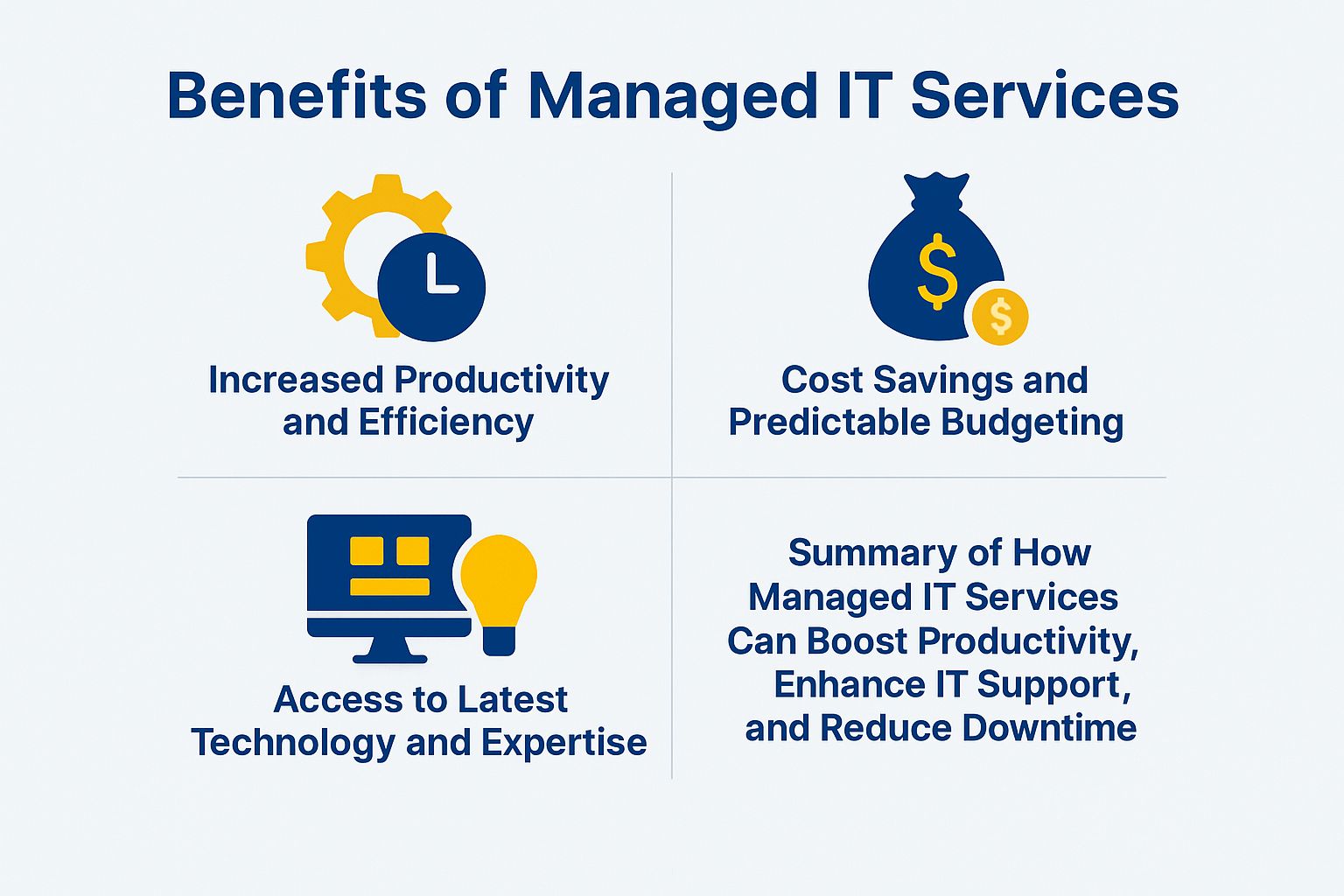
Increased Productivity and Efficiency
Managed IT Services increase productivity and efficiency. They allow organizations to focus on core operations without the complexities of IT management.
These services streamline processes through workflow automation. They offer robust IT support and utilize productivity tools. This enhances employee productivity and improves performance metrics.
Managed IT Services integrate advanced tools and technologies. They reduce the time employees spend on routine tasks. This allows employees to focus on more strategic initiatives. This approach ultimately leads to better business continuity and a more effective allocation of resources.
The result is a cohesive environment. Employees feel empowered, engaged, and equipped to reach their full potential. This drives the organization toward its goals more efficiently.
With timely IT support and remote support capabilities, teams can address issues swiftly, minimizing downtime and ensuring seamless operations through effective user support.
Cost Savings and Predictable Budgeting
One key benefit of Managed IT Services is significant cost savings. They also provide strategic IT planning and predictable budgeting. By outsourcing IT needs, organizations can allocate resources more efficiently, thereby reducing the financial burden associated with maintaining an in-house IT department. This approach not only enhances operational efficiency but also allows for improved financial management and strategic planning.
Managed IT Services give the power to businesses to transition from a fixed cost structure to a variable one, enabling them to pay only for the services they utilize, which boosts productivity and improves equipment monitoring. This flexibility is especially beneficial during periods of fluctuating demand, ensuring that expenditures align closely with organizational needs.
Specialized providers manage IT operations. Companies can leverage advanced technology and expertise without substantial up-front investments typically associated with capital expenditures. As a result, this fosters streamlined budgeting, reduces unexpected costs, and allows financial resources to be redirected toward innovation and growth.
Access to Latest Technology and Expertise with IT Solutions
A significant advantage of Managed IT Services is access to the latest technology and expertise. This includes network security and endpoint management. It can be a game-changer for businesses that want to stay competitive.
With continuous software updates and technology integration, organizations can achieve digital transformation while ensuring IT compliance with industry standards. This access enables businesses to leverage cutting-edge solutions that enhance their IT strategy and overall performance.
By partnering with knowledgeable service providers, companies can adopt innovative tools and platforms that streamline operations and improve efficiency. This professional support not only assists in navigating the complexities of cybersecurity threats and regulatory requirements but also fosters agility in responding to market changes.
As businesses continue to evolve, having a reliable Managed IT Services provider ensures they remain ahead of the curve, transforming challenges into opportunities and maintaining a robust online presence in an increasingly digital landscape. This approach aligns with the principles outlined in our analysis of integrating IT services for seamless business operations, enabling companies to seamlessly adapt to technological changes.
Summary of How Managed IT Services Can Boost Productivity, Enhance IT Support, and Reduce Downtime
Managed IT Services enhance productivity and reduce downtime for organizations. By providing reliable technical support, effective risk management, and continuous system monitoring, these services ensure business continuity and optimal performance across the IT infrastructure.
These services streamline operations. They enable employees to concentrate on core business activities instead of dealing with technical issues. Proactive maintenance minimizes the likelihood of unexpected failures, which could result in costly disruptions.
With customized solutions that address the unique needs of each business, Managed IT Services also improve collaboration and communication systems, ultimately fostering a more agile and responsive work environment.
The integration of these services promotes innovation and drives growth, offering a competitive advantage in today’s fast-paced market through effective resource allocation and process streamlining.
Frequently Asked Questions
What are managed IT services and how do they reduce downtime?
Managed IT services involve outsourcing IT management and maintenance to a third-party provider. These services include proactive monitoring, regular maintenance, and troubleshooting. They minimize downtime and ensure smooth IT system functioning.
How can managed IT services boost productivity in my organization?
Managed IT services boost productivity in many ways. They improve communication tools and workload management. By handling routine IT tasks, employees can focus on their main responsibilities without interruptions. Managed IT services ensure IT systems run efficiently. This reduces potential downtime that can hinder productivity.
What are some common causes of IT downtime and how can managed IT services prevent them?
IT downtime can be caused by hardware failures, cyber attacks, and human errors. Managed IT services prevent these issues. They implement measures like regular backups, security updates, and 24/7 monitoring to identify and fix problems before downtime.
How do managed IT services help with disaster recovery and business continuity?
Managed IT services are crucial for disaster recovery, change management, and business continuity planning. By backing up data regularly and having a disaster recovery plan, managed IT services help businesses quickly resume operations after an unexpected event.
Can managed IT services be customized to fit the specific needs of my organization?
Yes, managed IT services can be tailored to meet your organization’s unique needs, including help desk services and IT alignment. A reputable provider will work with you to understand your goals. They will design a customized plan that aligns with your objectives and budget.
What are the cost benefits of using managed IT services for my business, including virtualization and client satisfaction?
Managed IT services help businesses save costs in many ways. Outsourcing IT management helps companies avoid costs related to hiring and training in-house IT staff. With proactive maintenance and timely troubleshooting, managed IT services prevent costly downtime and disruptions.

